Deepest node in a binary tree
Category: Data Structures
The rightmost node among the leaf nodes is known as the deepest node in a binary tree. Find the deepest node in a binary tree solution with examples and algorithm.

Deepest node in a tree
The rightmost node among the leaf nodes is known as the deepest node in tree.

To find the deepest node in a binary tree we can traverse through all the the nodes in a tree and return the rightmost node among the leaf nodes.
Example -
Input:
1
/ \
2 3
/ \ / \
4 5 6 7
/
8
\
9
Output: 9
Solution
For the solution, we have to traverse each node and this can be achieved by using level order traversal and at the end return the deepest node.
Algorithm
Deepest_Node(root)
1. if root is null then return null
2. node = null
3. queue.enqueue(root)
4. while queue is not empty
5. queue.dequeue()
6. if node.left is not null
7. queue.enqueue
8. if node.right is not null
9. queue.enqueue
10. return node.data
Python
import queue
class Node:
def __init__(self, data):
self.left = None
self.data = data
self.right = None
def deepest_node(root):
if root is None:
return None
node = None
q = queue.Queue()
q.put(root)
while not q.empty():
node = q.get()
if node.left:
q.put(node.left)
if node.right:
q.put(node.right)
return node.data
root = Node(1)
root.left = Node(2)
root.right = Node(3)
root.left.left = Node(4)
root.left.right = Node(5)
root.right.left = Node(6)
root.right.right = Node(7)
print(deepest_node(root))
JavaScript
class Node {
constructor(data) {
this.left = null;
this.data = data;
this.right = null;
}
}
function deepestNode(root) {
if (!root) return null;
let node = null;
q = [];
q.push(root);
while (q.length > 0) {
node = q.shift();
if (node.left) q.push(node.left);
if (node.right) q.push(node.right);
}
return node.data;
}
const root = new Node(1);
root.left = new Node(2);
root.right = new Node(3);
root.left.left = new Node(4);
root.left.right = new Node(5);
root.right.left = new Node(6);
root.right.right = new Node(7);
console.log(deepestNode(root));
Output
7
Time complexity: The time complexity of this solution is O(n) because we are just traversing each element of node one by one.